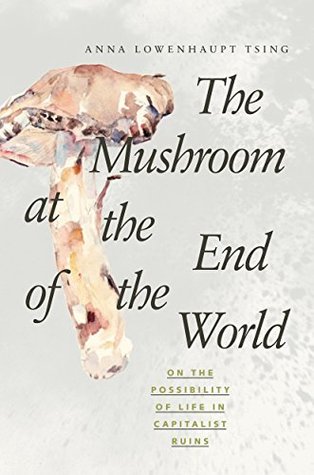More on this book
Community
Kindle Notes & Highlights
Other authors use “assemblage” with other meanings.
Polyphony is music in which autonomous melodies intertwine. In Western music, the madrigal and the fugue are examples of polyphony. These forms seem archaic and strange to many modern listeners because they were superseded by music in which a unified rhythm and melody holds the composition together.
we are used to hearing music with a single perspective. When I first learned polyphony, it was a revelation in listening;
This kind of noticing is just what is needed to appreciate the multiple temporal rhythms and trajectories of the assemblage.
But other kinds of farming have multiple rhythms. In the shifting cultivation I studied in Indonesian Borneo, many crops grew together in the same field, and they had quite
different schedules.
Factory labor is an exemplar of coordinated progress time. Yet the supply chain is infused with polyphonic rhythms.
hardly know how to think about justice without progress. The problem is that progress stopped making sense.
One answer is contamination. We are contaminated by our encounters; they change who we are as we make way for others. As contamination changes world-making projects, mutual worlds—and new directions—may emerge.
Everyone carries a history of contamination; purity is not an option.
One value of keeping precarity in mind is that it makes us remember that changing with circumstan...
This highlight has been truncated due to consecutive passage length restrictions.
Please open yourself to another usage. This book argues that staying alive—for every species—requires livable collaborations.
Collaboration means
working across difference, which leads to...
This highlight has been truncated due to consecutive passage length restrictions.
While practitioners of each have had little to do with each other, the twins set up similar frames. At the heart of each is the self-contained individual actor, out to maximize personal interests, whether for reproduction or wealth.
The assumption of self-containment made an explosion of new knowledge possible. Thinking through self-containment and thus the self-interest of individuals (at whatever scale) made it possible to ignore contamination, that is, transformation through encounter.
Self-contained individuals are not transformed by encounter.
Without the possibility of transformative encounters, mathematics can replace natural history and ethnography. It was the productiveness of this simplification that made the twins so powerful, and the obvious falsity of the original premise was increasingly forgotten.
Economy and ecology thus each became sites for algorithms of progress-as-expansion.
Precarity is a state of acknowledgment of our vulnerability to others.
Collaboration is work across difference,
The diversity that allows us to enter collaborations emerges from histories of extermination, imperialism, and all the rest. Contamination makes diversity.
If categories are unstable, we must watch them emerge within encounters.
To use category names should be a commitment to tracing the assemblages in which these categories gain a momentary hold.
Fire suppression was the biggest result: Loggers and foresters could agree on it.
The great ponderosa stands were logged out by the 1980s. It turned out that they could not reproduce without the periodic fires the Forest Service had stopped.
Surprisingly, in this ruined industrial landscape, new value emerged: matsutake.
The abundance of matsutake is a recent historical creation: contaminated diversity.
Yet almost all U.S. scholarship on Southeast Asian refugees ignores ethnic formation in Southeast Asia.
Transformation through collaboration, ugly and otherwise, is the human condition.
They brought a distinctive script, based on Chinese characters and used for writing to spirits.8 As both refusal and acceptance of Chinese authority, the script is a neat expression of contaminated diversity:
Mien are not known for their respect for national boundaries; communities have repeatedly crossed back and forth, especially when armies threaten.
To understand how Mien came to be matsutake pickers requires considering their relationship with another group now in the Oregon forests, Hmong.
A mid-twentieth-century millennial movement started by an illiterate farmer produced a completely original Hmong script.
Emerging from the trash of war, this distinctive and multiply derivative Hmong script, like that of the Mien, is a wonderful icon for contaminated diversity.
It is hard to think of a better example of contaminated diversity.
War, he argues, creates ethnic identities.15 War forces people to move but also cements ties to reimagined ancestral cultures.
I hope that at this point you are saying, “This is hardly news! I can think of plenty of similar examples from the landscape and people around me.” I agree; contaminated diversity is everywhere.
Why don’t we use these stories in how we know the world? One reason is that contaminated diversity is complicated, often ugly, and humbling.
Worse yet, contaminated diversity is recalcitrant to the kind of “summing up” that has become the hallmark of modern knowledge.
Contaminated diversity is not only particular and historical, ever changing, but also relational.
It has no self-contained units; its units are encounter-ba...
This highlight has been truncated due to consecutive passage length restrictions.
If a rush of troubled stories is the best way to tell about contaminated diversity, then it’s time to make that rush part of our knowledge practices.
is in listening to that cacophony of troubled stories that we might encounter our best hopes for precarious survival.
Such interwoven rhythms perform a still lively temporal alternative to the unified progress-time we still long to obey.
TO LISTEN TO AND TELL A RUSH OF STORIES IS A method. And why not make the strong claim and call it a science, an addition to knowledge?
Its research object is contaminated diversity; its unit of analysis is the indeterminate encounter.
Yet it is just these interruptions that step out of the bounds of most modern science, which demands the possibility for infinite expansion without changing the research framework.
The ability to make one’s research framework apply to greater scales, without changing the research questions, has become a hallmark of modern knowledge.
Progress itself has often been defined by its ability to make projects expand without changing their framing assumptions. This quality is “scalability.”


